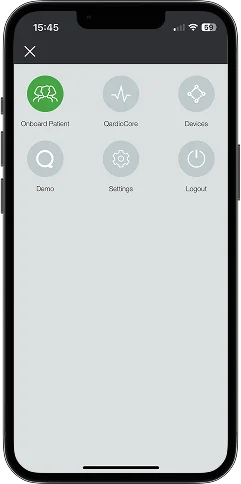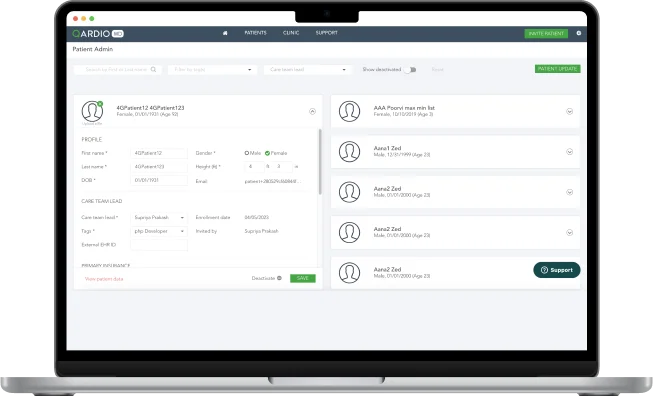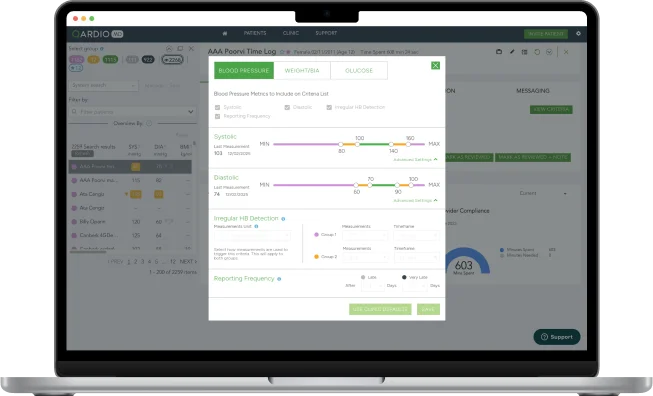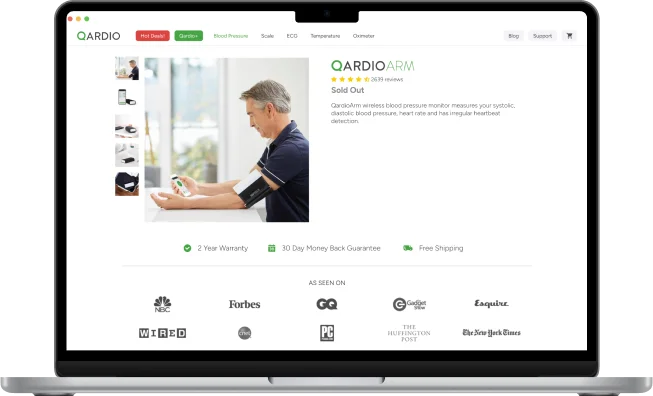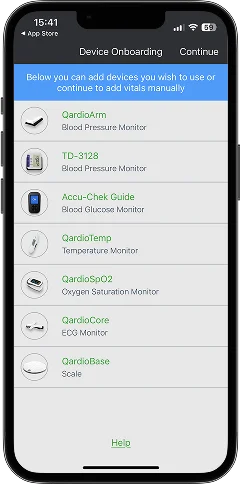Qardio
Discover how Qardio partnered with Aimprosoft to turn an initial concept into a fully integrated, IoT-driven healthcare platform. Starting with a basic mobile app and a few devices, Qardio’s vision evolved into a healthcare ecosystem that included mobile apps for patients and doctors, a web platform, and seamless device integrations.

Foreword
Our partner turned to us with a concept for an IoT-powered healthcare solution. Over time, the project evolved into a comprehensive ecosystem capable of supporting Qardio’s growing user base and expanding product offerings. Through our partnership, we helped Qardio build a robust product that could seamlessly grow with the company’s business objectives, all while ensuring a smooth user experience and reliable performance across all applications.
Download as PDF-
Services provided
Web development, QA and Software testing, DevOps services, Mobile development
-
Team
5 Backend developers, 4 Frontend developers, 4 QA engineers, 2 DevOps engineers, 1 Software architect, 3 Mobile developers
-
Cooperation model
Dedicated team
-
Duration
June 2012 – October 2024
-
Industry
Healthcare, IoT
-
Country
USA
Story
In 2012, the US startup approached us with a mere idea: to create an IoT-based solution that would allow users to monitor their health with the help of wearable devices seamlessly. At the time, it was still a concept, but the potential was obvious. Our task was to build a comprehensive ecosystem — a suite of interconnected applications, devices, and services that would support users in monitoring their health condition..
Over the years, this project evolved, and our new tasks included building both mobile and web platforms, creating custom APIs, and ensuring that Qardio’s ecosystem could scale effectively.
As we worked together, Qardio gave us more autonomy to take on new tasks independently, while making the ecosystem scalable. With each iteration phase, we added and improved features, such as health metrics collection and secure data management, as well as various integrations with 3rd-party systems, including Google Fitness, Chargebee, and others.
Our work has always been about more than just delivering code; it was about building trust with Qardio, solving complex problems together, and delivering solutions that could grow with their vision. Over the course of 12 years, we became a critical part of their journey, helping them evolve from a startup idea to a fully-fledged healthcare platform that serves more than 3 million active Qardio users.
-
12 yearsof a successful partnership with Qardio
-
Billionsof health measurements tracked worldwide
-
3 millionactive users
- 30%
Requirements & Challenges
Requirements & Challenges
As Qardio grew, our team moved from building one mobile app from scratch that connected to a few devices, to developing a complex ecosystem that covers a growing range of devices, including pulse oximeters, smart blood pressure monitors, and others.
At the outset, we faced a business challenge: coordinating logistics with their device manufacturing partner. We had to build a system that manages the flow of products from the manufacturer, integrating it with our partner’s platform to automate order processing and shipment tracking.
Another challenge was defining Qardio’s system architecture and mapping out exactly how the mobile app would function, as well as the web platform for healthcare professionals. The larger challenge was making their entire ecosystem scalable so it would support Qardio’s fast-growing user base, an urgent need for microservices architecture became obvious.
We also had to include subscription models to position Qardio’s system for new revenue streams, and build with future device integrations in mind, crucial to Qardio’s long-term success. Our mission-critical tasks included:
- Matching business growth with ecosystem expansion: Working closely with Qardio’s team to adapt and match their long-term business goals to efficient custom integrations, services, and features.
- Integration with healthcare devices:Connections between Qardio’s platform and various healthcare devices, including blood pressure monitors, smart scales, and ECG devices, had to run uninterrupted for real-time tracking, secure data transmission, and synching.
- Data security:Maintaining compliance with United States health data standards while protecting system vulnerabilities.
- Continuous development and technical complexity: Evolving projects required continuous updates and feature releases; we carefully balanced developing new functionality and maintaining and expanding their existing platform.
- Building scalable infrastructure:Developing a modern, microservices-based architecture to handle an influx of users, integrate with various diverse devices, and support ambitious growth without compromising performance.
- Performance monitoring:Integrating a comprehensive set of DevOps monitoring tools and performance metrics to spot potential bottlenecks and avoid downtime, while allocating resources to maintain high performance.
Features
Stack
- — Platform
- — Frontend
- — Backend
- — QA tools
- — Mobile
- — DevOps
- — Third-party tools
- Liferay
- Android
- iOS
- Angular.js
- jQuery
- React.js
- React hooks
- Pug
- Material-UI
- D3.js
- Java
- Spring stack
- MySQL
- Feign
- Gradle
- Charles
- Android Studio
- Postman
- JUnit
- Mockito
- Android SDK
- Android Wear
- Android Support Library
- Swift
- Xcode
- Jenkins
- AWS CodeDeploy
- AWS ECR
- Kubernetes EKS
- AWS EC2
- Kafka
- AWS CloudWatch
- Prometheus
- Grafana
- Google Fitness
- Google Cloud Messaging
- Google Analytics
- Crashlytics
- Samsung Digital Health SDK
- ChargeBee
- Sendbird
- RedoxEngine
Project outcomes
Project outcomes
As the project progressed, Qardio evolved into a comprehensive, scalable healthcare solution that seamlessly integrates with various devices and services. Our collaboration enabled Qardio to achieve significant business growth, including the following outcomes:
- From concept to a full turnkey solution implementation: Thanks to our close collaboration, we played a key role in transforming Qardio`s initial idea into a complete turnkey solution. We developed a scalable mobile app, web platform, and integrated healthcare devices, enabling Qardio to bring their vision to life. By managing the project from concept to completion, we delivered a comprehensive product suite that enabled Qardio to provide a complete healthcare solution, meeting the needs of both users and healthcare providers.
- Revenue growth enablement: Our work significantly contributed to Qardio`s revenue and product growth by developing various subscription models for clinics and patients, which opened up new revenue streams and expanded their market reach. Additionally, we facilitated the integration with other medical platforms, further boosting Qardio`s presence in the healthcare sector. This strategic approach helped drive engagement, with over 3 million active Qardio users and a 97% positive user rating, ultimately ensuring steady growth and solidifying Qardio`s position in the market.
- Long-term strategic growth and ecosystem expansion: Over our 12-year partnership, we positioned Qardio’s long-term growth, from idea to a complete platform that can support ongoing business growth indefinitely and adapt to new devices and user needs. We helped them open up to opportunities, diversify their offerings, and create new revenue streams.
- Scalable infrastructure for growth: We helped Qardio build a scalable microservices architecture that could seamlessly handle their growing user base and integrate with an expanding range of devices. This foundation allowed the platform to scale effectively and support future growth without compromising performance.
- Enhanced performance and stability: Our team identified key performance bottlenecks, such as duplicate requests, and implemented fixes that dramatically improved the speed and reliability of Qardio’s applications. This contributed to a more stable system, enhancing the overall user experience.
- 24/7 infrastructure support and cost optimization with DevOps: By actively monitoring the infrastructure, scaling resources as needed, and implementing robust security measures, we ensured that the platform remained highly available and operational at all times. This continuous support not only helped avoid downtime but also allowed us to optimize resource usage and avoid unnecessary spending on outdated Kubernetes clusters.
Let’s talk
The most impactful partnerships start from a first conversation – so let’s have one!
Are you ready to turn your unique concept into a feature-rich IT product? Leverage our experience in building scalable, user-centric solutions to turn your idea into reality.
Contact us directly via
Visit our HQ in
Cyprus, Nicosia, Griva Digeni, 81-83 Jacovides Tower, 1st floor
Meet our representatives in
The UK, Spain, Bulgaria, Poland, and over 15 other European countries
Hey Aimprosoft,
We’ve received your message and will get back to you shortly.
Contact us directly via
Visit our HQ in
Cyprus, Nicosia, Griva Digeni, 81-83 Jacovides Tower, 1st floor
Meet our representatives in
The UK, Spain, Bulgaria, Poland, and over 15 other European countries


